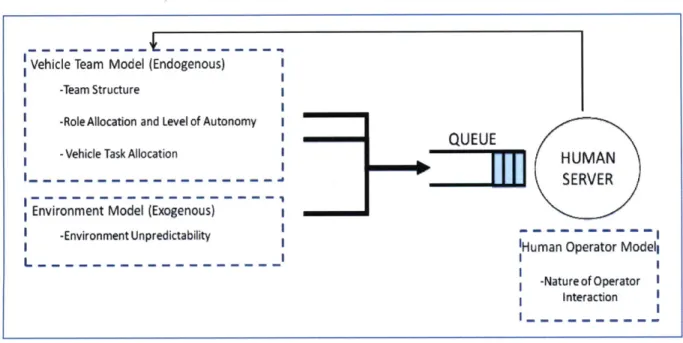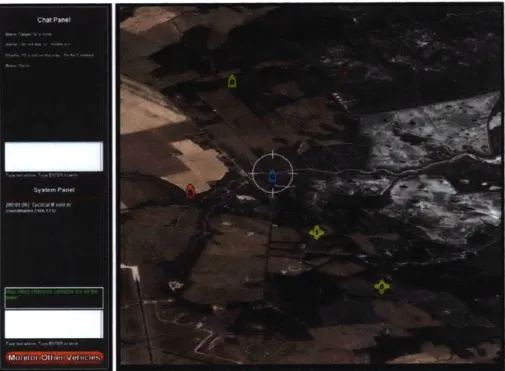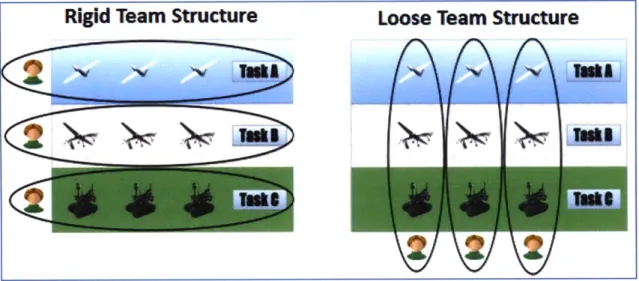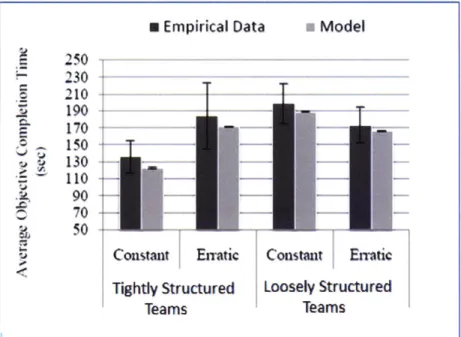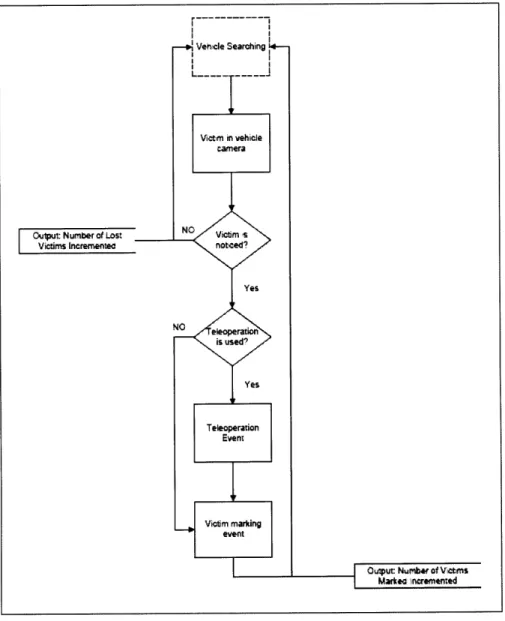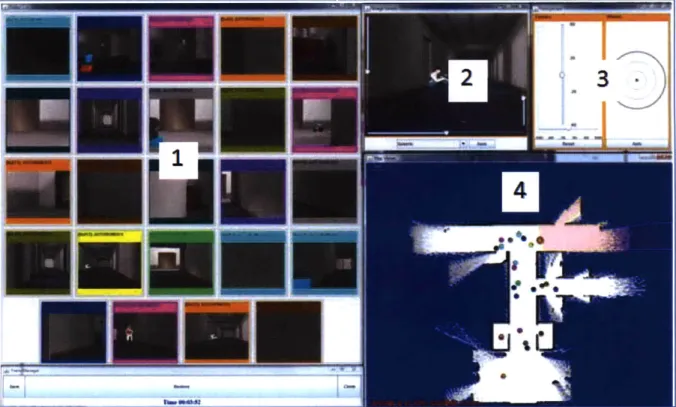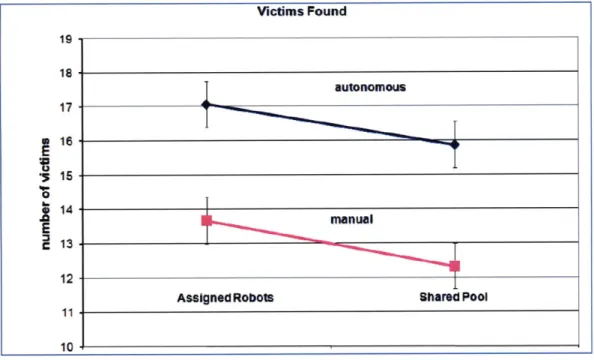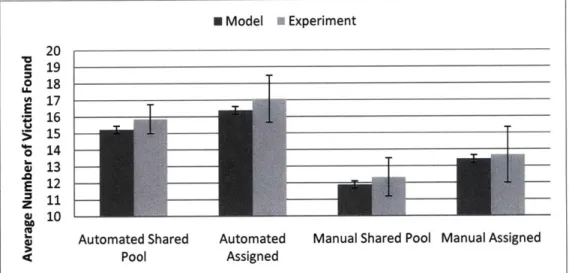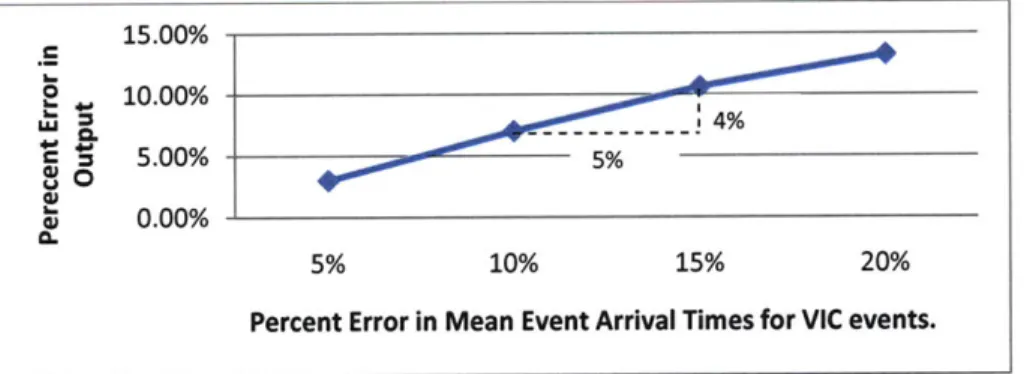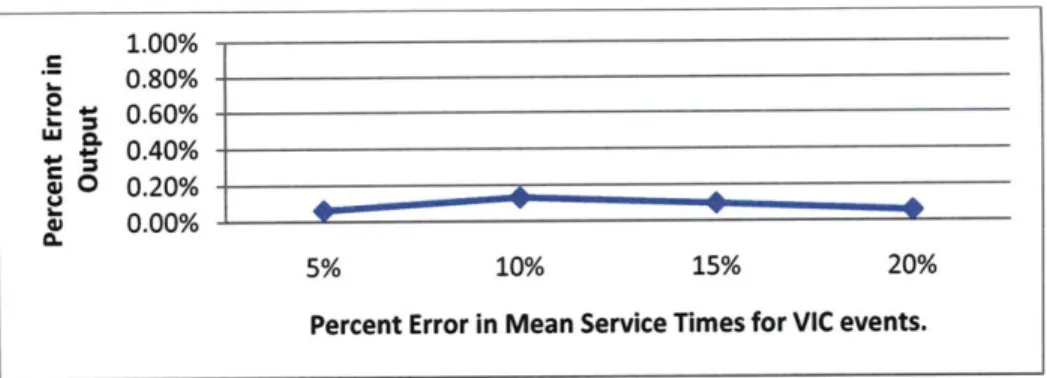A Discrete Event Simulation Model
For Unstructured Supervisory Control
Of Unmanned Vehicles
by
Anthony D. McDonald
Submitted to the Department of Mechanical Engineering in Partial
Fulfillment of the Requirements for the Degree of
Bachelor of Science at the
Massachusetts Institute of Technology
June 2010 MASSACHUSETTS INSTITUTE OF TECHNOLOGY
JUN 3
0
2010
LIBRARIES
ARCHNES
@ 2010 Anthony D. McDonaldAll rights reserved
The author hereby grants to MIT permission to reproduce and to
distribute publicly paper and electronic copies of this thesis document in whole or in part in any medium now known or hereafter created.
Signature of Author... .. ... ...
Department of Mechanical Engineering May 10, 2010
Certified by ...
Associate Professor of ronautics
Mary L. Cummings and Astronautics and ESD Thesis Supervisor
Accepted by...
John H. Lienhard V Loiiins i-roressor or Mechanical Engineering Chairman, Undergraduate Thesis Committee
A Discrete Event Simulation Model For Unstructured Supervisory Control
Of Unmanned Vehicles by
Anthony D. McDonald
Submitted to the Department of Mechanical Engineering on May 10, 2010 in partial fulfillment of the requirements for the Degree of Bachelor of Science in Mechanical Engineering
Abstract
Most current Unmanned Vehicle (UV) systems consist of teams of operators controlling a single UV. Technological advances will likely lead to the inversion of this ratio, and automation of low level tasking. These advances will also lead to a growth in UV use in large-scale applications such as urban search and rescue, which will require the use of both teams of operators and teams of UVs. This growth will in turn require research and development in the area of team supervisory control of multiple UVs. Human-in-the-loop experimentation is often used during this research but can be time consuming and expensive. The time and cost of experimentation can often be drastically reduced by using predictive models. However there is a lack of such models in the area of operator supervisory control of multiple-UVs.
This problem is addressed in this thesis through the following method: First, current predictive models of human supervisory control of UVs are analyzed, and attributes of systems related to this modeling space are identified. Second, a queuing-based multiple-operator multiple-vehicle discrete event simulation model (MO-MUVDES) is developed which captures these attributes, including the ability to predict performance in situations with low observable exogenous event arrivals. MO-MUVDES also incorporates traditional system variables such as level of vehicle autonomy, vehicle and operator team structure, and operator switching strategy.
The accuracy and robustness of the MO-MUVDES model were measured by a two-stage validation process using data from a human-in-the-loop supervisory control experiment, and a Monte Carlo simulation. The first stage of the validation process used data from the experiment as input for the MO-MUVDES model which was then used to generate predictions of operator performance. In the second stage of validation, a sensitivity analysis was performed on the MO-MUVDES model. This validation process achieved confidence in the model's ability to predict operator performance and a measurement of the robustness of the model under varying input conditions. Additionally, the process indicated that discrete event simulation is an effective technique for modeling team supervisory control of UVs in a situation where exogenous event arrivals are not clearly observable. As a result, the MO-MUVDES model could be used to reduce development time for systems within its modeled space.
Thesis supervisor: M.L. Cummings
Acknowledgements
First and Foremost, I would like to dedicate this thesis to the memories of my grandfather, John D. McDonald, and my great grandfather, Thomas Renner. They are responsible for generating my interest in science and technology, and are both driving influences behind my work and success at MIT.
I would like to thank my father and mother. You have not only funded my education at MIT, but have always supported and encouraged me in every way possible. Without you, I would have never made it as far as I have.
I would also like to thank my brother, Andy, and my girlfriend, Christina. Both of you have provided me with an enormous amount of support and love throughout my years at MIT.
Beyond the love and support of family, the most important person involved in a project such as this is a mentor. In light of this I would like to thank Missy Cummings, my thesis advisor and mentor for this project. I enjoyed our work together immensely and I look forward to conducting more research with you in the future.
In addition I would like to thank the following individuals:
Yves Boussemart: Thank you very much for serving as my mentor, reading and providing feedback on my thesis, and being a great friend throughout my time at HAL.
Ivan Amador: Ivan, Thank you for your help with data analysis. Having your assistance was a great help during this project and I wish you the best of luck in your years at MIT.
Carl Nehme: Thank you for giving me the opportunity to work on your research, and introducing me to the world of discrete event simulation.
Table of Contents
Abstract... 2
Acknow ledgem ents...3
Index of Figures...6 1 Introduction ... 7 1.1 M otivation... 7 1.2 Research Questions...7 1.3 Research M ethodology ... 8 1.4 Thesis Organization ... 8 2 Background ... 9 2.1 Team Research ... 9
2.2 Discrete Event Sim ulation for Supervisory Control ... 10
2.3 M odeling M ultiple Hum an Operator UV Control using DES M odels ... 11
2.4 Sum ma .ry ... 14
3 M odel Developm ent ... 15
3.1 Overview ... 15
3.2 Discrete Event Sim ulation Constructs... 15
3.2.1 Events...15
3.2.2 Event Arrival Processes ... 16
3.2.3 Service Processes ... 16
3.2.4 Queuing Policy and Team Structure ... 17
3.2.5 Sum m ary ... 17
3.3 Im plem entation of M odel Constructs... 17
3.3.1 Events...18
3.3.2 Event Arrival and Service Processes... 19
3.3.4 M odel Output...19
3.4 Sum m ary ... 19
4 M odel Validation ... 21
4.1 Explanation of Experim ental Test Bed ... 21
4.1.1 Overview ... 21
4.1.2 interface ... 22
4.1.3 Operator Tasks ... 23
4.1.4 Participants and Experim ental Procedure ... 23
4.1.5 Experim ental Results... 23
4.2 Replication ... 25
4.3 Sensitivity Analysis ... 27
4.4 Sum m ary ... 29
5 Conclusions ... 30
5.1 M odeling Operator Team Supervisory Control of UVs ... 30
5.2 M odel Confidence ... 31
5.3 Future W ork ... 31
5.4 Contributions ... 32
References ... 33
Appendix A: M O-M UVDES Distribution Param eters and Types ... 35
Index of Figures
Figure 2.1: A high level representation of Nehme's DES model (Nehme 2009)...10
Figure 2.2: A screenshot of the simulation game used in Mekdeci et al.'s development (2009). ... 11
Figure 2.3: A graphical depiction of the two team structures modeled in Mekdeci et al. (2009)...12
Figure 2.4: Graphical representation of Mekdeci and Cummings(2009) model . ... 13
Figure 2.5: A graph of empirical and model results for Mekdeci et al. DES model (2009)...13
Figure 3.1: Sample Event stream from MO-MUVDES model ... 18
Figure 4.1 The MrCS interface with the four main sections numbered ... 22
Figure 4.2: A graphical depiction of the average victims found with 95% confidence (Lewis et al. 2009).24 Figure 4.3: A graphical depiction of the average victims lost with 95% confidence (Lewis et al. 2009).... 24
Figure 4.4: Results for average number of victims found compared with the model replication... 26
Figure 4.5: Results for average number of victims lost compared with the model replication... 26
Figure 4.6: Impact of errors in estimates of mean arrival times for VIC events on the model output. ... 27 Figure 4.7: Impact of errors in estimates of mean service times for VIC events on the model output. 28 Figure 4.8: Impact of errors in estimates of mean service times for Teleoperation Events on output. 28
1
Introduction
1.1 Motivation
The use of teams is prevalent in unmanned vehicle (UV) operations (DoD 2009). In addition to military scenarios, UV use is also expanding in civilian applications. These applications include reconnaissance, payload delivery, communication, surveillance, search and rescue, border patrol, amongst others (Nehme, Crandall et al. 2008). With this expansion comes the need for new UV command and control designs, capable of accommodating the cognitive loads of teams of increasing size and complexity. Designing new teams that integrate humans and unmanned vehicles is an iterative process that can be slow and cumbersome, especially when user experimentation is needed, which can be costly in time and other resources. Predictive simulation models capable of predicting mission performance given various system parameters could be used to replace some experimentation and therefore provide expedite the design process.
One predictive modeling technique that has been used to successfully model human-UV control is Discrete Event Simulation (DES). DES is especially effective because it is temporally event-based and it utilizes simulation output as a predictive measure. While DES has been shown to be effective in the single operator-multi UV case (Nehme 2009) and in some multiple operator-multiple UV applications (Mekdeci and Cummings 2009), these previous efforts assumed that events that required system response (e.g., the emergence of an enemy target) were clearly observable by operators. However, such models can be problematic because event "arrival" may not be immediately obvious to users. This situation creates a problem for previous models because in those systems, events are generated based on discrete beginnings and endings of other events. In situations where event arrivals are ambiguous, previous models break down. This thesis reports on (1) the creation of a DES model that accounts for such unobservable event arrivals, and (2) the evaluation of this new model on an experimental human-in-the-loop data set.
1.2
Research Questions
The primary question investigated in this research effort is whether or not it is possible to use discrete event simulation to model a team of operators exercising supervisory control of multiple unmanned vehicles in a scenario where exogenous event arrivals are not clearly observable events. This work will also explore the effects of vehicle team structure, operator, and team switching strategy on mission performance and operator task load.
1.3 Research Methodology
The research questions were investigated via the following steps:
Step 1: Model Development: Develop a discrete event simulator of a team of operators exercising supervisory control of multiple unmanned vehicles in a scenario where exogenous event arrivals are not immediately observable. This model utilizes a Monte Carlo simulation to translate random event arrivals into a discrete distribution.
Step 2: Model Validation: Use this model to predict the results of a historical human-in-the-loop data set (Lewis, Wang et al. 2009). In particular, the predictions of interest are the mission outcome metrics such as number of lost victims and found victims during a scenario, as well as operator task load. Finally, a sensitivity analysis of the model is performed by adjusting the mean of each input variable and comparing the output variables to a control data set.
1.4 Thesis Organization
The remainder of this thesis is organized as follows:
Chapter 2: Background, summarizes research done in the areas of team performance in military command and control operations and previous research where discrete event simulation has been used to model supervisory control of unmanned vehicles.
Chapter 3: Model Development, introduces the model structure and the components of the discrete event simulation.
Chapter 4: Model Validation, discusses the accuracy of the predictions of the model and the results of sensitivity analysis of the model.
Chapter 5: Conclusions, summarizes the motivations, goals, and findings of this research and provides suggestions for future work.
2
Background
This chapter first introduces UV-research which demonstrates that teams are a necessary entity of both civilian and military UV control. Previous research also highlights the necessity for predictive models which explore team performance issues in supervisory control of multiple unmanned vehicles. In addition, recent research involving the successful use of discrete event simulation queuing models in single operator and multi-operator supervisory control situations where exogenous events are clearly demarcated is discussed. This overview demonstrates the need for a DES model of loosely structured team control of multiple UVs with low visibility exogenous events. Finally, a summary of the research is presented, and a brief overview of the proposed model is given.
2.1
Team Research
Teams are found in a wide variety of settings, from sports fields to battlefields, urban crisis zones or emergency responses. Salas et al. (1992) defined a team as "a collection of two or more individuals working together to achieve a common goal". The idea of a common goal is important because it leads to behaviors such as backing up a teammate in case of failure, which promotes team robustness. Teamwork itself relies on a member's knowledge of the goals of the team as well as the mission plan and the current state of the environment. This knowledge is frequently referred to as mutual awareness or the teams "shared mental model" (Rouse, Cannon-Bowers et al. 1992; Cannon-Bowers, Salas et al. 1993). It also allows the team to adapt internally and make changes such as resource reallocation and in some cases team restructuring. These behaviors are "important to try to simulate to get the most
realistic performance out of (...) teams in constructive simulations" (loerger 2009).
There have been many successful predictive mathematical models of team performance (Coovert and McNellis 1992; Kleinman, Luh et al. 1992; Coovert, Craiger et al. 1995; Sorkin, Hays et al. 2001). In particular, Coovert and McNellis (1992) used Petri nets to model team performance. This method is effective but can become overly complicated and time consuming when complex systems are modeled. The majority of previous research centers on team task allocation, and is less focused on other dependencies such as expertise and individual workload. Because teamwork and team performance is highly dependent on the system state, i.e., the current condition of the operators and vehicles, models which can capture such states are valuable for the design process of real-time systems. One such type of
2.2 Discrete Event Simulation for Supervisory Control
Discrete event simulation is a widely-used technique that has been used to successfully model supervisory control of systems such as healthcare (Brailsford and Schmidt 2003) and manufacturing systems (Rohee and Riera 2009). However, Nehme et al. (2008) were the first to demonstrate the effectiveness of the technique in the context of single operator supervisory control of unmanned vehicles. Nehme's (2009) model combined the use of discrete event simulation with an operator queuing model as well as implementing attention inefficiency penalties and operator switching strategies.
A high level representation of Nehme's model is shown in Figure 2.1. The model uses event inter-arrival times and service times as input. Events can either be exogenous, i.e. generated by the environment, or endogenous, i.e. generated by a vehicle or an operator. The generality of the model allows for a wide variety of mission performance output variables such as events completed, operator utilization and wait times.
Vehicle Team Model (Endogenous)
I
-Team Structure
-Role Allocation and Level of Autonomy I
I QUEUE
-Vehicle Task Allocation
--- -- -- -- - - --SERVER-
--- Environment Model (Exogenous)
Iz
-Environment Unpredictability
lHuman Operator Model L - - - - -
---Nature of Operator Interaction
Figure 2.1: A high level representation of Nehme's DES model (Nehme 2009).
Nehme's DES model was validated with several sets of human in the loop data (Nehme, Mekdeci et al. 2008; Nehme 2009). The research demonstrated that discrete event simulation could be a viable technique for modeling human behavior in unmanned vehicle supervisory control. Nehme's research was based on the assumption of a single operator multiple unmanned vehicle situation. However, as pointed in the previous section, teams are a ubiquitous part of the vast majority of military or civil
service application. So there is a need to expand on Nehme's research and create models of teams of operators supervising teams of unmanned vehicles.
2.3 Modeling Multiple Human Operator UV Control using DES Models
Recently Mekdeci and Cummings (2009) developed a multiple human operator discrete event simulator. This work was an expansion of Nehme's earlier model, and their major contributions were the inclusion
of communication and team structure and these effects on task allocation.
The framework developed by Mekdeci et al. was based on an unmanned vehicle simulation (see Figure 2.2 for a screenshot) in which the goal for the team was to send vehicles to targets in order to identify them as friendly or hostile, and then to send another vehicle to the target to either send aid to or destroy the targets. During the game, three users each supervised a team of three vehicles. The teams were either completely rigidly structured (i.e. each user controlled three vehicles of the same type) or loosely structured (i.e. each user controlled one surveillance vehicle, one vehicle with aid packages, and one with weapons to destroy targets). A graphical summary of the team structures is shown in Figure 2.3. The simulation used objective completion time as its performance metric.
Figure 2.2: A screenshot of the simulation game used in Mekdeci et al.'s model development (2009).The clover shaped, numbered icons represent targets, and the red, blue, and yellow polygons represent vehicles.
The objective completion time is the time from a target's appearance on the map to the time in which the user drops an aid package or destroys the hostile target. This is important because in order to model
this result with a DES, the model must be designed to function in situations where event arrivals and event completion times are clear.
Figure 2.3: A graphical depiction of the two team structures modeled in Mekdeci et al. (2009).
Mekdeci et al. developed their multiple operator, multiple vehicle DES model based on the data gathered during experimentations. Figure 2.4 shows a graphical representation of this model with event flows. There are three key differences between this model and Nehme's earlier work:
(1) Mekdeci et al.'s model utilizes three separate operator queues. This idea is a natural extension of Nehme's work, which paired one operator with one queue, but it is important because it allows each operator to have their own switching strategy as opposed to one team queue which would only model team switching strategy.
(2) Communication and performance monitoring are modeled as endogenous events created by the operator, and referred to as coordination strategy. Communication and performance monitoring are contributions of Mekdeci et al. and do not appear in Nehme's model because they are team-specific events.
(3) Mekdeci and Cummings use only objective completion time as the predictive output of the model. Nehme's model can output a variety of mission performance metrics, including objective completion time, as well as queuing specific metrics such as wait time and operator utilization.
Mission Effectivness
(Objective Completion Tirm
Figure 2.4: Graphical representation of Mekdeci and Cummings(2009) model.
In order to validate the model, Mekdeci et al. compared the output of the model with the results of the simulation game experiment. The results of this comparison are shown in Figure 2.5. The results shown compare loosely and tightly structured teams, and constant (every 30 seconds) and erratic
(concentrated at the one quarter and three quarter marks of the simulation) target arrival times.
a Empirical Data a Model
is
250-i-230t 210-.3 190-170 - 150-S130 110 - --90z
70
50Constant
Erratic
Constant
Erratic
Tightly Structured Loosely Structured
Teams Teams
Figure 2.5: A graph of empirical and model results for Mekdeci et al. DES model (2009). Error bars are 95% confidence.
... ... . ... ... ... .. .... ... ... ... _._ ... ... ..
Vehicle Type Level of Automation
In all four conditions, the Team DES model predicted average objective completion times within 95% confidence. Mekdeci et al.'s Team DES model successfully predicted experimental results, but its design introduces some limitations. The Team DES model uses average objective completion time as its predictive metric. In order to find objective completion time, the Team DES model must have exact start and end times of target/goal interaction. This means that the model cannot take into account the arrival of events that are not noticed by the operators. These types of scenarios in which operators are searching to targets that could go unnoticed are becoming more common with the increased use of UVs in civilian situations such as urban search and rescue and border patrol. Thus, while the Team DES model made several important contributions, most notably modeling communication and mutual performance monitoring, the fact that the model is ineffective for scenarios where event arrivals are not immediately observed by operators creates a need for a multiple operator, multiple vehicle DES model for supervisory control which can handle such events.
2.4 Summary
Teamwork is an essential part of many activities including military and civilian rescue situations. While a wide variety of models exist to predict team performance, many of them focus on aspects of teamwork that are less applicable to supervisory control. Nehme (2009) developed a successful discrete event simulator model for a single operator supervising a team of heterogeneous unmanned vehicles. Mekdeci and Cummings (2009) continued his work and created a model of teams of operators supervising teams of unmanned vehicles. Their model was also successful but required event arrivals to be clearly defined and immediately noticed by the operators. This research proposes the development of a new discrete event simulation model as an extension of Mekdeci and Cummings work. It will address the gap in the current research and provide a mechanism for handling low observable exogenous events. The specific details of this model design are discussed in the next chapter.
3 Model Development
In this chapter a queuing-based multiple operator, multiple unmanned vehicle discrete event simulation (MO-MUVDES) model is presented. First, an overview is offered which discusses the assumptions made by this model, and the model's attributes are described. This is followed by the presentation of DES-based constructs which allow the model to capture the behavior of a team of operators supervising multiple unmanned vehicles, and the identification of the design variables which provide input to the model. Finally the output metrics measured by the MO-MUVDES model are discussed along with the potential benefits of the proposed model to address the gaps in current research.
3.1
Overview
This model makes several assumptions. It addresses a UV system in which a team of operators supervises a team of homogenous unmanned vehicles. It is specifically designed to model situations in which event arrivals are not immediately observed by the operators. The location of the operators is independent of the system, and it is assumed that communication between the operators exists. Operators are assumed to act in a supervisory control manner and thus interact with vehicles at only discrete time intervals, although role allocation and vehicle autonomy can be system variables. These attributes and their implementation in the model are explained in detail after the basic constructs of discrete event simulation.
3.2
Discrete Event Simulation Constructs
There are four essential elements to a discrete event simulator: events in the system, the arrival processes of those events, the service processes of those events, and the queuing procedure (Nehme 2009). In a team discrete event simulation, there is an additional element related to queuing procedure: the operator team structure. Each of these elements is discussed in the following section.
3.2.1 Events
Events are typically separated into three separate categories depending on their origins: environmental events, vehicle-generated events, and operator-generated events. Because of the specificity of this model, only environmental and operator-generated events are modeled in this research effort.
Environmental events are events that arise unexpectedly during a mission. They are caused by environmental unpredictability, and require operator attention and interaction (Nehme 2009). Environmental events could be the appearance of a victim in the camera of a search and rescue UV, or an emergent threat to vehicle safety such as a fire in the path of a vehicle.
Operator-induced events are events that are created by an operator. These events are endogenous to the system and often occur as an operator attempts to improve system performance such as adjusting a vehicle's pre-planned trajectory. In this case, an operator could begin to teleoperate a vehicle or take control of the onboard camera in order to get a better view of a potential victim in the environment.
3.2.2 Event Arrival Processes
Every event type in the system has an associated arrival process. There are two types of arrival processes that are essential in modeling supervisory control, independent and dependant (Nehme 2009). The MO-MUVDES model contains one independent arrival process and one dependant arrival
process.
Independent arrival processes are associated with exogenous events. The arrivals of exogenous events are independent of previously-created events and the state of the operator team. Thus, an additional victim could appear in the camera of a vehicle regardless of whether or not the operator handled the last Victim in Camera (VIC) event successfully. Since this type of event arrival is independent of previously-generated events, it can be characterized by a random variable, X, which represents the inter-arrival time between events. Furthermore, the distribution of inter-arrival times can be defined by a probability density function, fx(x). In the MO-MUVDES model, there is one independent arrival process, thus the arrival rate can be modeled as (Nehme 2009):
= , where E[X]>0 (1)
Unlike independent arrival process, dependent arrivals are completely dependent on previously generated events. In the MO-MUVDES model, dependent event arrivals are associated with operator generated events. These events occur when the operator takes control of a vehicle in order to find the exact location of a victim, and to mark that location. Their arrival is dependent on the arrival of a VIC event. Additionally, the arrival of these events is dependent on operator attention, which is modeled with a Bernoulli distribution, with a success probability, p.
3.2.3 Service Processes
In addition to having an associated arrival process, each event type has an associated service process. The service process represents event interaction. Service processes are similar to independent arrivals in that they can be modeled with a random variable, Y, which exists within the probability density
lifetimes, the length of time a victim appears in a vehicle's camera, and the time between vehicle selection and a victim being marked (Select-to-Mark service time).
3.2.4 Queuing Policy and Team Structure
Queuing policy refers to the order in which operators choose to service multiple events in the queue. The policy may be based on a traditional method such as the first in-first out (FIFO), or last in-first out (LIFO) schemes, but may also be dynamic, dictated by the environment or operator preferences. These policies can be applied an operator queue, or a shared queue between operators.
In a multiple operator, multiple unmanned vehicle control case, queuing policy is highly dependent on operator team structure. For example, some events may only be serviced by team members of a certain position, or by an operator controlling a specific vehicle type. In the MO-MUVDES model, operator teams are either tightly or loosely structured, as in the previous Mekdeci and Cummings model (2009). The model allows for a variety of queuing strategies but is limited in the tightly structured case because operators cannot service events from vehicles not assigned to them.
3.2.5 Summary
The MO-MUVDES model is derived from the four main elements of the MUV-DES model, as defined by Nehme (2009). This methodology requires each system event to be identified and mapped to an event type. This event type dictates the arrival and service processes for every event. In the independent arrival and service processes, the respective inter-arrival and service times are defined by random variables which exist within a given probability distribution. Dependant arrival processes are defined by the arrivals of independent events and a Bernoulli process', which represents operator attention. The final element, queuing policy dictates the order in which events are serviced in the system. In the presence of an operator team, queuing policy is defined and driven by team structure.
3.3 Implementation of Model Constructs
The following sections discuss the implementation of the MO-MUVDES model, applied to a multiple operator-multiple robot search-and-rescue task where operators either supervise multiple robots moving about unknown environments autonomously searching for possible victims, or engage a single robot through teleoperation control in order to more precisely explore an area of interest.
1 A Bernoulli process consists of a random variable with only two values, 0 and 1. In this case, the process is used to
3.3.1 Events
A vehicle event stream for the MO-MUVDES is shown in Figure 3.1. The solid boxes represent discrete events in the system. Thus, the system event library consists of VIC events, Teleoperation events and victim marking (Select-to-Mark) events. VIC events are environmental events, and Teleoperation and Select-to-Mark events are operator-generated events.
Figure 3.1: Sample Event stream from MO-MUVDES model.
The MO-MUVDES models search and rescue scenarios in which automated vehicles in terms of navigation are monitored by operators. The time in which a vehicle is searching but does not have a VIC event is represented by the dashed box labeled vehicle searching in Figure 3.1. When a VIC event arrives, a Bernoulli distribution, represented by a diamond in Figure 3.1, is used to model operator
Output Number of Lost
attention. If the event is noticed, it is added to an operator's queue until it is serviced. When the event is serviced, another Bernoulli distribution is used to model the choice to create a Teleoperation event before marking a victim. After the Teleoperation event is finished, or if the event is not created, a victim marking event is added to the operator queue. Once this event is completed, the vehicle returns to searching.
3.3.2 Event Arrival and Service Processes
The MO-MUVDES model event library contains both environmental and operator-generated event types. These event types can be mapped to independent and dependent arrivals. VIC event arrivals can be characterized as independent arrival processes. The inter-arrival time for these events is defined by the probability distributionf,(v). Teleoperation and Select-to-Mark events are dependent on the arrival of VIC events. Their inter arrival rate is defined by f,(v) and two Bernoulli distributions. The first Bernoulli distribution represents limited operator attention and the probability that a VIC event is unnoticed. The second represents the operator's need for further information on victim location.
The service processes for each event type are also defined by probability distributions, g,(v') for VIC events and gt(t) for Teleoperation events, with the exception of Select-to-Mark events. Select-to-Mark service times are small and have an insignificant level of variance, so they are assumed to be constant, at 3 seconds.
3.3.3 Queuing Processes and Team Structure
The queuing policy in the MO-MUVDES model is flexible, but dependent on team structure. Given the search-and-rescue nature of this application of MO-MUVDES, priority queuing strategies are not employed because there is only one event type, VIC events, in operator queues; however, traditional queuing strategies such as FIFO are supported.
3.3.4 Model Output
The MO-MUVDES model supports the measurement of several output variables. The system is capable of measuring traditional DES metrics such as queuing wait times, and operator utilization as well as mission specific performance metrics.
3.4 Summary
The MO-MUVDES model was developed following Nehme's (2009) method. Three types of events were identified that characterized human supervisory control of a search-and-rescue task: Victim in Camera, Teleoperation, and Select to Mark. These events were mapped to arrival and service processes, which
are either defined by a random variable drawn from a probability distribution, or dependant on another process. Finally a queuing policy was developed based on operator team structures and classic queuing methods, such as FIFO or LIFO. The following chapter discusses the validation of this model through its application to a historical data set (Lewis, Wang et al. 2009).
4 Model Validation
In this chapter, the results of validation process of the MO-MUVDES model are discussed in the context of the previously-described search-and-rescue application. Validation is an important aspect of model development because it allows users to develop trust in the model's predictions, and in some cases defines the bounds of the modeled space. The chapter will first discuss the historical data set used for building the conceptual MO-MUVDES model. A thorough understanding of this data set is essential because of its use in model development and replication validation. Following this discussion, the validation process will be detailed. The process used in this research is a two-stage validation:
Stage 1: Replication
The model assumptions were tested and the input-output relationships of the model and data set were compared. This process developed confidence in the models predictions and determined robustness under various input parameters.
Stage 2: Sensitivity Analysis
A sensitivity analysis on the model input was performed. This testing developed further confidence in the robustness of the model.
This chapter will conclude with a summary of the validation results and a discussion of their potential implications.
4.1
Explanation of Experimental Test Bed
This section introduces the test bed which provided the historical data set used in this experiment. The test bed is a virtual unmanned vehicle simulation, in which operators supervised teams of unmanned vehicles in order to find and mark the location of victims in a burning building.
4.1.1 Overview
The experiment which provided the historical data set was performed with the USARSim robotic simulation (Lewis, Wang et al. 2009). In the simulation, 24 Unmanned Ground Vehicle (UGVs) performed an urban search and rescue task in an office building. Each vehicle was equipped with an onboard camera. Several validation studies have shown close agreement between the robots modeled in the USARSim and real robots in similar situations. The results of these studies are reported in Lewis et al. (2005), Carpin et al. (2006), and Taylor et al. (2007). The simulator is designed to allow a team of two
operators to perform supervisory control over the 24 vehicles, with a variety of team structures and vehicle autonomy. The experiment in Lewis at al. (2009) utilized two team structures: Shared Pool, where both operators could control 24 unmanned vehicles, and Assigned, where each operator was assigned 12 vehicles. These resemble the tightly and loosely structured teams from the previously-discussed team study (Mekdeci and Cummings 2009). Additionally two levels of vehicle autonomy were studied: Manual, where operators had to manually path plan for vehicles by creating waypoints, and Automated, where the vehicles planned their paths autonomously. An extensive summary of this test bed and the data collected can be found in Lewis et al. (2009).
4.1.2 Interface
Operators interact with the USARSim using the Multi-robot Control System (MrCS). The MrCS interface consists of four sections and is shown in Figure 4.1. The left half of the interface (numbered 1 in Figure 4.1) contains thumbnail camera views for each vehicle that the operator has the ability to control.
Figure 4.1 The MrcS interface with the four main sections numbered (1 Robot camera thumbnails, 2 Selected Robot camera view, 3 Robot control interface, 4 Map view) (Lewis, Wang et al. 2009).
An operator can click on any of the thumbnails contained in the section to select a vehicle. Section 2 of the interface contains an enlarged view from the onboard vehicle camera of the currently-selected vehicle. Section 3 provides controls which allow the user to adjust the onboard vehicle camera or
teleoperate the currently-selected vehicle. A map of the environment is shown in section 4 of Figure 4.1 The MrCS interface with the four main sections numbered (1 Robot camera thumbnails, 2 Selected Robot camera view, 3 Robot control interface, 4 Map view) (Lewis, Wang et al. 2009). The map shows the current location of each vehicle via a colored dot. The color of the dots corresponds to the frame of that vehicle's thumbnail in section 1. The current vehicle is shown as an enlarged dot and its camera view range is mapped by a shaded red region. By clicking on the map users are able to set vehicle waypoints (in the manual path planning case) and mark victim locations.
4.1.3 Operator Tasks
The primary task for the operators in this experiment was to find and mark the location of the victims in the environment. In the manual case operators had to manually plan the path of the vehicles by creating waypoints. After the vehicles had an assigned path, the operators were instructed to observe the thumbnails until a victim appeared in one of them. At this point operators could either take control of the vehicle and teleoperate it to achieve a better view before marking the victim, or simply mark the victim on the map.
4.1.4 Participants and Experimental Procedure
The experiment consisted of a 2x2 between groups study, which crossed autonomy and team organization. The participants in this study were 120 undergraduates from the University of Pittsburgh (60 male and 60 female), all of whom were compensated for their participation. The participants were divided into 60 teams of 2 and then completed a basic training scenario which explained the basic features of the interface and the goals of the experiment. Following training each team participated in one of the four treatment conditions.
4.1.5 Experimental Results
The variables of interest for evaluating the MO-MUVDES model were the number of victims found during the simulation and the number of victims lost. Lewis et al. (2009) also recorded the total area of the map explored and the number of victims found per unit area, however these metrics were supplementary measures of mission performance and thus, were not evaluated with the MO-MUVDES model. For MO-MUVDES, the number of victims found was the number of victims located and marked in the simulation. The number of lost victims was the total number of victims who appeared a vehicle's camera but were not marked by an operator. In Lewis et al. (2009), these events are referred to as "Missed Victim Opportunities." A graphical depiction of these results is shown in Figure 4.2 and Figure 4.3.
Victims Found 19-autonomous 16. *s 16 14-A1 manual E C 13 12
AssignedRobots Shared Pool
11 10
-Figure 4.2: A graphical depiction of the average victims found with 95% confidence (Lewis et al. 2009). Missed Victim Opportunities in Teams
90 80 0 - A s s ig n e d R o b o t s E 60 SharedPool 0 E So 40 Autonomous Manual 30
Figure 4.3: A graphical depiction of the average victims lost with 95% confidence (Lewis et al. 2009).
The ANOVA for marked victims found no significant difference between the two different team structures, but found a main effect for autonomy (F1.56=13.436, p=0.001). Student t-tests were also performed and showed a difference in level of autonomy for both team structures: shared pool, .
t(28)=3.398, p=0.002, and assigned, t(28) = 2.152, p=0.04. Similar results were shown for missed victim opportunities.
4.2 Replication
In an effort to determine the model's ability to describe observed data, data sets from Lewis et al. (2009) and a Monte Carlo Simulation were used to generate inputs to the MO-MUVDES model. The model was then used to replicate the results for each of the four treatments from the data.
The MO-MUVDES model supports three different event types: Victim in Camera, Select-to-Mark, and Teleoperation. Each of these events has an associated probability distribution for service times, with the exception of Select-to-Mark events. Select-to-Mark events have a relatively small service time, and an insignificant level of variance, so these service times are modeled as a constant 3 seconds. Additionally, VIC events have an associated probability distribution for event arrival time. The fitted distribution types for the event service times and their parameters were generated using the historical data set and the EasyFit© software. The distribution type and parameters for VIC event arrivals were generated with a Monte Carlo Simulation and the EasyFit* software.
A Monte Carlo Simulation is an estimation method which was used in this case because VIC event arrival times were not recorded by Lewis et al. (2009). The simulation was conducted by obtaining sample arrival times from the USARSim. These samples were obtained from 15 recorded videos of the simulation run on the shared pool, automated path planning case. The samples indicated that vehicles generally could be categorized into three groups based on their arrivals: low (vehicles with 0 or 1 event arrivals over the course of the 15 minute tests) medium (vehicles with 2 to 5 arrivals in 15 minutes), and high (vehicles with 5 or more arrivals in 15 minutes). In order to replicate these categories, three categories of event arrival distributions were created. The high event arrival distribution was generated using the EasyFit* software and the sample data from the recorded videos. The low and medium event arrival distributions were developed independently of the sample data, because the sample data was based on a 15 minute test, whereas the actual simulation data were taken from 25 minute tests. A normal distribution with a mean of 37.5 minutes was assigned to the low event arrival distribution, and a uniform distribution with boundaries at 1 and 37.5 minutes, was assigned to the medium event arrival distribution. Based on the average amount of vehicles that fell into the low (42%) medium (33%), and high (25 %), categories, 24 event arrival distributions were created and randomly assigned to vehicles in the MO-MUVDES model. In order to model the manual conditions, the mean of the high event arrival
distribution was decreased by 25%. This adjustment was calculated using the found victim data from Lewis et al. (2009), which reported that 25% fewer victims were found in the manual case. Thus it was estimated that 25% fewer VIC event arrivals occurred in the manual conditions. The service and arrival distributions are summarized in Appendix A.
Using the distributions generated from the data set and the Monte Carlo simulation, 1000 trials were performed with the MO-MUVDES model. Found and lost victim results were replicated for each of the four conditions, and were directly compared to the experimental results. The average amount of found and lost victims are shown in Figure 4.4 and Figure 4.5 respectively, and detailed in Appendix B.
0 Model n Experiment 20 19 0 18 U-17 A16
5
15 0 14 13 E 12 Z=11 W 10Automated Shared Automated Manual Shared Pool Manual Assigned
Pool Assigned
Figure 4.4: Results for average number of victims found compared with the model replication.
Figure 4.5: Results for average number of victims lost compared with the model replication.
* Model U1 Experiment CA90
E
80T
70 S60 S50 0~-40
.030 E =20 a'10 S0Automated Shared Automated ManualShrdPoMaulAsge
Assigned
Pool ... ... .... ... ...
-r
The model results for both found and lost victims are within 95% confidence intervals for all the conditions. However, in the lost victim comparison, the model predicted significantly better for the automated conditions than the manual conditions. This is likely due to small errors in the event arrival predictions in the automated conditions, which are magnified by the estimation method for manual VIC event arrival times. The ANOVA test utilization results showed no significant difference between the four conditions, which agrees with the results of the experiment. These results are significant because they add confidence in the model to predict vehicle team performance while capturing operator
behavior.
4.3 Sensitivity Analysis
A sensitivity analysis is a technique used to measure how errors in input affect output in a computational model. It is important that the output of a discrete event simulation model is not overly sensitive to errors in input. Additionally, if certain inputs are highly sensitive to error, it is desirable to have knowledge of them to ensure that they are made sufficiently accurate before the model is used. For the MO-MUVDES model, a sensitivity analysis was conducted on the VIC event arrival and service times, and the Teleoperation service times. These event types were chosen because they demonstrate examples of input from both the experimental data set and the Monte Carlo Simulation, and they account for a significant amount of the operator task load. Errors were introduced to these event variables by shifting the mean values of the probability distributions that defined them. Errors of 5% to 20% were introduced at 5% intervals. The output errors were estimated by comparing the total number of found and lost victims from the original replication output vs. the total number of lost and found victims after introducing errors to the input. The results of these comparisons are shown in Figure 4.6,
Figure 4.7, and Figure 4.8.
15.00% 0 10.00% 4% C 5.00% 5% 0 0.00% 5% 10% 15% 20%
Percent Error in Mean Event Arrival Times for VIC events.
Figure 4.6: Impact of errors in estimates of mean arrival times for VIC events on the model output (total amount of lost and found victims).
1.00% C ' 0.80% 0 i 3 0.60% 0 0.40% S 0.00% a. 5% 10% 15% 20%
Percent Error in Mean Service Times for VIC events.
Figure 4.7: Impact of errors in estimates of mean service times for VIC events on the model output (total amount of lost and found victims). 5.0% ' 4.0% a z 3.0% LU CL S2.0% 2.3% 1.0% _ _ _ _ _ _ __ _ _ _
a*
0.0% 5% 10% 15% 20%Percent Error in Mean Service Times for Teleoperation Events
Figure 4.8: Impact of errors in estimates of mean service times for Teleoperation Events on the model output (total amount of lost and found victims).
As can be seen in Figure 4.6, the most significant observation that can be made from this data is that there is an approximately linear relationship between errors in mean VIC event arrival times and error in output, a 5% increase in error in mean arrival times causes approximately a 4% increase in error in output. This result means that the Monte Carlo Simulation is not a robust way to measure VIC event arrivals. However, the MO-MUVDES model predicted the amount of lost and found victims within the 95% confidence intervals extracted from the historical data set, it can be concluded that the Victim in Camera mean was also predicted inside of that confidence interval. Very little error is seen in Figure 4.7, however a linear error progression similar to Figure 4.6 is seen in Figure 4.8, with Teleoperation events. In the latter, a 10% increase in input causes 2.3% increase in error of output which is significantly less than with VIC event arrivals. This result should be noted, but it is less concerning than VIC because of the smaller slope and the fact that Teleoperation events arrivals are well defined, and thus easier to measure accurately.
Another important observation is that errors in arrival distributions have a more significant effect on output than errors in service distributions. This effect can be explained by the fact that the service times are relatively small (on the order of 15 seconds in a 25 minute scenario), and the fact that the operator
task load is minimal. These conditions mean that even with large increases in service time, operator queues will not become saturated and thus operators will still be able to service approximately the same amount of events. On the contrary if event arrivals are increased operator queues will begin to fill up and operator mission performance will be immediately affected.
4.4 Summary
The validation process discussed in this chapter resulted in confidence being developed in the MO-MUVDES model's ability to make predictions and knowledge of its robustness under varied input conditions. The model was first used to predict the results of a simulation experiment in which a team of operators supervised a team of unmanned vehicles. The results showed that the MO-MUVDES model is able to capture operator performance and task load for varying team structures and levels of vehicle autonomy. In order to gain further confidence in the model and understand its robustness, a sensitivity analysis was performed. The analysis revealed that the model is most sensitive to errors in event arrivals, although in general the model proved to be robust.
5
Conclusions
Advances in unmanned vehicle control technology are expected to invert the current ratio of many operators to one vehicle. However these advances will also lead to UV use in large scale operations such as search and rescue, which will require operators controlling teams of UVs to work together. Therefore, it is reasonable to assume that in the future, UV systems will need to accommodate both teams of operators and teams of vehicles. Designing for these advanced systems will require large scale human in the loop experimentation which will be costly. In order to address this issue a simulator based model, the MO-MUVDES model, was developed to support prototyping efforts of UV systems. This chapter summarizes the creation, development, and validation of the MO-MUVDES model. Additionally, the chapter gives suggestions for future work and discusses the contributions of this research.
5.1
Modeling Operator Team Supervisory Control of UVs
Through review of existing literature, a need for a discrete event simulation of teams of operators supervising a team of unmanned vehicles in a scenario where event arrivals are not immediately observed by operators was developed. This need was filled through the development of a discrete event simulation model with a Monte Carlo Simulation to estimate event arrivals. This model was developed by first identifying four attributes essential to a multiple operator: multiple vehicle discrete event simulation: events, event arrival processes, event service processes, operator queuing procedure, and operator team structure. These attributes were mapped to design variables which were used to develop the basic structure of the MO-MUVDES model.
The MO-MUVDES model consists of three event types: Victim in Camera events, Teleoperation Events, and Select-to-Mark events. Each of these events has an associated arrival process and service process. Victim in Camera event arrivals should be independent exogenous events. Teleoperation and Select-to-Mark event arrivals are dependent on Victim in Camera event arrivals. The service processes are defined by two independent random variables, g,(v') for VIC events, gt(t) for Teleoperation events, and a constant, 3 seconds, for Select-to-Mark events. These events and their associated arrival and service processes serve as input for the MO-MUVDES model. Additional inputs include vehicle team structure, operator team structure, and operator queuing strategy. Using this input, the MO-MUVDES model provides a variety of output, which can be used to measure traditional team metrics such as operator utilization, or mission performance.
5.2 Model Confidence
Confidence was established in the MO-MUVDES model in a two stage process. First, the model was used to predict mission performance and changes in operator task load using data from a previous supervisory control experiment. Second, a sensitivity analysis was performed on the model. In addition to adding confidence to the model, this analysis led to a measure of model robustness.
The supervisory control experiment data used in to test the MO-MUVDES model was independently collected by Lewis et al. (2009). The experiment examined changes in level of vehicle autonomy and operator team structure. The data from the experiment were used to create probability distributions which defined event service times for the model. However, Lewis et al. did not report data on VIC event arrivals, so the probability distributions were created using a Monte Carlo simulation and sample data from the USARSim interface. The MO-MUVDES model was then used under each of the four conditions of the experiment and the mission performance output was compared to the results of the Lewis experiment. The model reproduced the results for each condition within 95% confidence. These results are important because they establish the feasibility of a discrete event simulation model for unstructured supervisory control of unmanned vehicles. Additionally it establishes confidence that the MO-MUVDES model could be used to make design recommendations for future systems in which teams of operators supervise teams of vehicles in scenarios where event arrivals are not always observed. In order to further develop confidence in the model, a sensitivity analysis was performed. This analysis was performed by shifting the mean of select distributions which provided event arrival and service times to the model. The analysis was performed on three distributions: Victim in Camera arrival time, Victim in Camera duration, and Teleoperation duration. These distributions were chosen because they represented input from both the data set and the Monte Carlo Simulation. The analysis proved that the MO-MUVDES model was for the most part robust, and was most sensitive to changes in event arrival times. These results led to further confidence in the use of the MO-MUVDES model for design recommendations.
5.3 Future Work
The current research on the MO-MUVDES model has developed a level of confidence in the model predictions and its construction. However there are four areas in which a substantial amount of future work could be completed. These areas are prediction improvements, validation, design recommendations, and generalization of the model. Before completing further validation, it would be
beneficial to attempt to predict manual condition event arrival times more accurately. This is important because the model showed some error in these predictions and any errors in output likely mean there is a more significant error in the estimation of event arrivals. This error in estimation is likely due to the Monte Carlo simulation method for estimating VIC event arrivals. Although this method provides a relatively accurate first order approximation for event arrival times, it is not based on observed experimental data. Further research should be conducted to find a better method for estimating these event arrival times which is derived from the historical data set. In addition, before using the MO-MUVDES model to provide design recommendations, it is essential that these tests are performed and that sufficient confidence is achieved. After this testing, the model could be used to provide design recommendations for the USARSim interface and the MRCs control interface. While these recommendations will be useful, the MO-MUVDES model needs to be generalized before it is used to make design recommendations for other control interfaces. This process will largely consist of expanding the event library so that a variety of independent and dependent events can be included in the input of the model, including communication and mutual performance monitoring.
5.4 Contributions
The aim of the work presented in this thesis was to answer the research questions posed in Chapter 1. Through resolving these questions, contributions have been made to the domain of operator team supervisory control of multiple unmanned vehicles. The most significant of these contributions is that it is possible to use discrete event simulation to model situations where exogenous event arrivals are not immediately observed. Additionally, this research demonstrated that Monte Carlo Simulation could be effective method for populating event arrival distributions, although it is not a robust method. This research also continued to show the effectiveness of discrete event simulation for supervisory control, and provided a model which could be used to make design recommendations for the USARSim interface. With future developments, the MO-MUVDES model could prove to be an effective tool for making design recommendations, and provide a basis for the development of similar models of supervisory control.
References
Brailsford, S. and B. Schmidt (2003). "Towards incorporating human behavior in models of health care systems: An approach using discrete event simulation." European Journal of Operational Research 150(1): 19-31.
Cannon-Bowers, J. A., E. Salas, et al. (1993). Shared Mental Models in Expert Team Decision Making. Individual and Group Decision Making: Current Issues. N. J. Castellan Jr. Hillsdale, NJ, Erlbaum: 221-246.
Carpin, S., T. Soyanov, et al. (2006). Quantitative assessments of USARSim accuracy. Proceedings of PerMis, Gaithersburg, MD.
Coovert, M. D., J. P. Craiger, et al. (1995). Innovations in Modeling and Simulating Team Performance: Implications for Decision Making. Team Effectiveness and Decision Making in Organization. R. A. Guzzo and E. Salas. San Francisco, Jossey-Bass Publishers: 149-203.
Coovert, M. D. and K. McNellis (1992). Team Decision Making and Performance: A Review and Proposed Modeling Approach Employing Petri Nets. Teams: Their Training and Performance. R. W. Swezey and E. Salas. Norwood, NJ, Ablex: 247-280.
DoD (2009). Unmanned Systems Integrated Roadmap FY2009-2034, United States Department of Defense.
loerger, T. R. (2009). Literature Review: Modeling Teamwork as Part of Human-Behavior Representation. College Station, TX, Texas A&M University.
Kleinman, D. L., P. B. Luh, et al. (1992). Mathematical Models of Team Performance: A Distributed Decision-Making Approach. Teams: Their Training and Performance. R. W. Swezey and E. Salas. Norwood, NJ., Ablex: 177-217.
Lewis, M., S. Hughes, et al. (2005). Validating USARsim for use in HRI research. 49th Annual Meeting of the Human Factors and Ergonomics Society, Orlando, FL.
Lewis, M., H. Wang, et al. (2009). Process and Performance in Human-Robot Teams. Pittsburgh, PA, University of Pittsburgh.
Mekdeci, B. and M. L. Cummings (2009). Modeling Multiple Human Operators in the Supervisory Control of Heterogeneous Unmanned Vehicles. 9th Conference on Performance Metrics for Intelligent Systems. Gaithersburg, MD.
Nehme, C. E. (2009). Modeling Human Supervisory Control in Heterogeneous Unmanned Vehicle Systems. Dept. of Aeronautics and Astronautics. Cambridge, MA, MIT. Ph. D.
Nehme, C. E., J. W. Crandall, et al. (2008). Using Discrete-Event Simulation to Model Situational Awareness of Unmanned-Vehicle Operators. Virginia Modeling, Analysis, and Simulation Center Capstone Conference. Norfolk, VA.
Nehme, C. E., B. Mekdeci, et al. (2008). "The Impact of Heterogeneity on Operator Performance in Future Unmanned Vehicle Systems." The International Command and Control Journal 2(2). Rohee, B. and B. Riera (2009). "Advanced supervisory control for manufacturing systems from concepts
to a separated monitoring system." Int. J. Intell. Syst. Technol. Appl. 6(3/4): 381-401.
Rouse, W. B., J. A. Cannon-Bowers, et al. (1992). "The Role of Mental Models in Team Performance in Complex Systems." IEEE Transactions on Systems, Man, and Cybernetics 22: 1296-1308.
Salas, E., T. L. Dickinson, et al. (1992). Toward an Understanding of Team Performance and Training. Teams, Theri Training and Performance. R. W. Swezey and E. Salas. Norwood, NJ., Ablex: 3-29. Sorkin, R. D., C. J. Hays, et al. (2001). "Signal-Detection Analysis of Group Decision Making."
Psychological Review 108: 183-203.
Taylor, B., S. Balakirsky, et al. (2007). Design and Validation of a Whegs Robot in USARSim. PerMis '07, Washington D.C.
Appendix A: MO-MUVDES Distribution Parameters and Types
Table 1 presents the fitted distribution types, parameters, and their p-values for the event arrival and service processes using the data from the Monte Carlo Simulation and Lewis et al. (2009). These distributions were generated using the EasyFit* Software package. In order to generate the event arrival times for the manual control case, the mean of the Victim in Camera high level event arrival distribution was adjusted by 25%.
Table 1: Summary of distributions for the MO-MUVDES model.
Event Type Event Generator Distribution Parameters p-value
Event arrival Time (high level of
Victim in Camera Gamma a=1.0405,0= 64.117 0.73042
arrivals)
VictimEvent arrival Time (Medium Uniform a= 60 b=2250
--level of arrivals) Event arrival Time (Low level of
Victim in Camera Normal a=50, p=2250
--arrivals)
Victim in Camera Duration Lognormal a=1.2311, p=2.7886 0.88164
